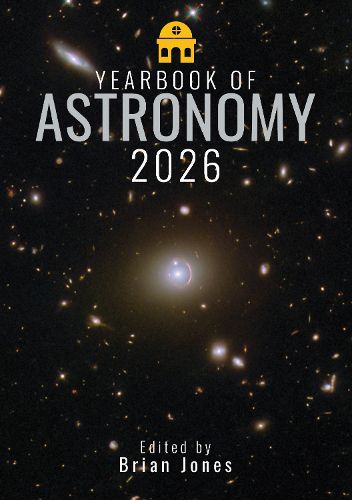Readings Newsletter
Become a Readings Member to make your shopping experience even easier.
Sign in or sign up for free!
You’re not far away from qualifying for FREE standard shipping within Australia
You’ve qualified for FREE standard shipping within Australia
The cart is loading…






Maintaining its appealing style and presentation, the Yearbook of Astronomy 2026 contains comprehensive jargon-free monthly sky notes and an authoritative set of sky charts to enable backyard astronomers and sky gazers everywhere to plan their viewing of the year's eclipses, comets, meteor showers and minor planets as well as detailing the phases of the Moon and visibility and locations of the planets throughout the year. To supplement all this is a variety of entertaining and informative articles, a feature for which the Yearbook of Astronomy is known. Presenting the reader with information on a wide range of topics, the articles for the 2026 edition include, among others, Recent Advances in Astronomy; Recent Advances in Solar System Exploration; Anniversaries in 2026; The Astronomers' Stars: Taking It to Extremes; Hawking Stars; Subrahmanyan Chandrasekhar and Professor A. S. Eddington; Planetary Protection; Nearby Worlds Out There: The Many Kinds of Exoplanet; Comets and Literature in the Nineteenth Century; On the Origin of NASA Names; Mission to Mars: Countdown to Building a Brave New World: Pausing for Thought; A History of Observatory Designs: The Telescope Age; and Sidewalk Astronomy: Cosmos to Kerbside. This iconic publication made its first appearance way back in 1962, shortly after the dawning of the Space Age. Now well into its seventh decade of production, the Yearbook continues to be essential reading for anyone lured and fascinated by the magic of astronomy and who has a desire to extend their knowledge of the Universe and the wonders to which it plays host. The Yearbook of Astronomy is indeed an inspiration to amateur and professional astronomers alike, and warrants a place on the bookshelf of all stargazers and watchers of the skies. AUTHOR: Brian Jones hails from Bradford in the West Riding of Yorkshire and was a founder member of the Bradford Astronomical Society. He developed a fascination for astronomy at the age of five when he first saw the stars through a pair of binoculars, and his interest took him into the realms of writing sky guides for local newspapers, appearing on local radio and television, teaching astronomy and space in schools and, in 1985, becoming a full time astronomy and space writer. As well as being editor of the Yearbook of Astronomy since the 2017 edition, Brian has penned around 20 books to date which have covered a wide range of astronomy- and space-related topics for both children and adults. His passion for bringing an appreciation of the universe to his readers is reflected in his writing. The minor planet 45689 Brianjones is named after him. 100 colour illustartions
$9.00 standard shipping within Australia
FREE standard shipping within Australia for orders over $100.00
Express & International shipping calculated at checkout
Maintaining its appealing style and presentation, the Yearbook of Astronomy 2026 contains comprehensive jargon-free monthly sky notes and an authoritative set of sky charts to enable backyard astronomers and sky gazers everywhere to plan their viewing of the year's eclipses, comets, meteor showers and minor planets as well as detailing the phases of the Moon and visibility and locations of the planets throughout the year. To supplement all this is a variety of entertaining and informative articles, a feature for which the Yearbook of Astronomy is known. Presenting the reader with information on a wide range of topics, the articles for the 2026 edition include, among others, Recent Advances in Astronomy; Recent Advances in Solar System Exploration; Anniversaries in 2026; The Astronomers' Stars: Taking It to Extremes; Hawking Stars; Subrahmanyan Chandrasekhar and Professor A. S. Eddington; Planetary Protection; Nearby Worlds Out There: The Many Kinds of Exoplanet; Comets and Literature in the Nineteenth Century; On the Origin of NASA Names; Mission to Mars: Countdown to Building a Brave New World: Pausing for Thought; A History of Observatory Designs: The Telescope Age; and Sidewalk Astronomy: Cosmos to Kerbside. This iconic publication made its first appearance way back in 1962, shortly after the dawning of the Space Age. Now well into its seventh decade of production, the Yearbook continues to be essential reading for anyone lured and fascinated by the magic of astronomy and who has a desire to extend their knowledge of the Universe and the wonders to which it plays host. The Yearbook of Astronomy is indeed an inspiration to amateur and professional astronomers alike, and warrants a place on the bookshelf of all stargazers and watchers of the skies. AUTHOR: Brian Jones hails from Bradford in the West Riding of Yorkshire and was a founder member of the Bradford Astronomical Society. He developed a fascination for astronomy at the age of five when he first saw the stars through a pair of binoculars, and his interest took him into the realms of writing sky guides for local newspapers, appearing on local radio and television, teaching astronomy and space in schools and, in 1985, becoming a full time astronomy and space writer. As well as being editor of the Yearbook of Astronomy since the 2017 edition, Brian has penned around 20 books to date which have covered a wide range of astronomy- and space-related topics for both children and adults. His passion for bringing an appreciation of the universe to his readers is reflected in his writing. The minor planet 45689 Brianjones is named after him. 100 colour illustartions